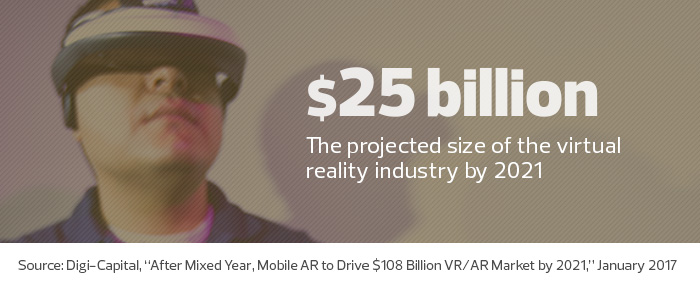sponsor content What's this?
Virtual Reality Helps FEMA, VA Bring Their Missions to Life

Presented by
FedTech

Agencies can enhance therapy and training with VR due to increased availability and lower price points.
Five years ago, virtual reality seemed more like an alternate reality than a true possibility for many agencies.
Building a virtual reality environment, where projectors displayed images on the walls of a tailored room, could cost hundreds of thousands of dollars. In addition, VR headsets were clunky and too pricey for agency budgets, says Tuong Nguyen, principal research analyst at Gartner.
Since then, a wave of sleeker, more affordable VR headsets from vendors such as HTC and Samsung has hit the market. Some are powered via smartphone, some are wired to a PC or gaming console, and some don’t require an external source.
Now agencies are finding new uses for the technology, inspired by the devices’ lower cost and wider availability.
VR Makes Disaster Scenarios Feel Real
“Virtual reality has become more popular,” Nguyen says. “The government has used it in the past for military and aeronautics. Those were custom-built systems. Now, you can fit that whole environment literally on your head for a few hundred dollars.”
For example, when the Federal Emergency Management Agency (FEMA) wanted to demonstrate to local officials how flooding can affect communities, it created a VR environment called Immersed that puts users in the shoes of a decision-maker during a flooding situation.
FEMA collaborated with a communications firm, mitigation engineering firm, technology company, and floodplain and emergency management experts to develop and design Immersed. The agency officially released the virtual reality experience, which requires a headset and sensors to track participants’ movement, in May.

“FEMA is always interested in exploring new technologies,” says Stephanie Moffet, an agency spokesperson. “Research is showing that VR can be a powerful tool for impacting people’s perceptions and actions in the real world. VR tools like Immersed can help make risk more real — and let users see firsthand the impact of taking mitigation actions.”
The Veterans Affairs Department follows similar reasoning. The Miami VA Healthcare Systembegan using VR technology three years ago, after the chief of psychiatry, Dr. Daniella David, heard about software to help treat patients with post-traumatic stress disorder.
“Trauma memories are different than regular memories; they tend to be burned into memory in a more dramatic way and also be fractured,” says Chris M. Crowe, senior mental health consultant and liaison to the Defense Centers of Excellence for Psychological Health and Traumatic Brain Injury, a division of the Defense Health Agency. “The therapist helps the person piece back together what actually happened, and people are able to process feelings they have about it.”
VA therapists in Miami can guide patients, who wear a virtual reality headset, through scenes in Iraq and Afghanistan and insert experiences, such as explosions.
To date, the technology has helped the center treat about 30 patients. Three of the facility’s seven exposure therapists routinely use the tool in their sessions.
“Frequently, veterans come back from Iraq and Afghanistan and have repressed, particularly painful emotions,” David says. “The part most people felt was useful was being able to actually go through the experience graphically — not just imagining it as you normally would. Virtual reality has olfactory, visual and auditory stimuli that help them access emotions they can’t always access verbally.”
Immerse Users in a Virtual World
Other agencies have taken advantage of virtual reality to provide an enhanced user experience.
The Smithsonian’s Hirshhorn Museum and Sculpture Garden created a VR experience for a recent exhibit featuring artwork from Japanese artist Yayoi Kusama to accommodate guests with mobility impairments.
The exhibit’s enclosed Infinity Mirror Rooms required visitors to pass through 30-inch doorways and step onto 4-foot-wide platforms. Using a 2D and 3D game design program, the Hirshhorn built a digital version visitors with disabilities could view on Samsung VR headsets.

Because the virtual reality landscape has changed so rapidly, some agencies may struggle to recognize potential applications for the technology.
However, Gartner’s Nguyen believes the technical limitations will continue to fade away as the capabilities develop further. In time, he expects agencies will begin to consider the more lifelike experience virtual reality can offer.
“In the last 12 months, we’ve seen more people become familiar with the idea,” Nguyen says. “There are so many high-risk situations — military use, for example — where it helps to train people in a virtual environment first, rather than have them hit the ground running. There’s definitely an opportunity for the government to use it across the board.”
VR IS A SURPRISING RECRUITMENT TOOL
The U.S. Department of Agriculture’s Food Safety and Inspection Service has long faced retention issues with its inspectors and veterinarians who couldn’t handle the occasionally graphic work.
In response, Dean Norman, the agency’s distance learning branch chief, suggested creating an immersive environment to show candidates what the job entailed. Now, the agency incorporates virtual reality into its recruiting practices.
“If we had done something like this previously, everything would have been custom-built, and it would have been expensive,” Norman says. “The idea was to leverage consumer technology.”
Using six small cameras attached to a rig to provide a 360-degree view, FSIS filmed plant processes, such as hide removal and inspectors examining eviscerated animals. In May 2016, the agency sent footage of beef and chicken meat production, along with two Samsung Gear VR headsets, to each of its 10 districts, which began bringing the equipment to job fairs and recruiting events.
This year, the agency plans to send four additional headsets to each district.
“About 20 to 25 percent of candidates said they would not work in a slaughter plant,” Norman says. “That’s exactly the reaction we want. If you don’t think you can do it, it is better to know now than after we have spent the money to train and relocate you.
This content is made possible by FedTech. The editorial staff of Nextgov was not involved in its preparation.





